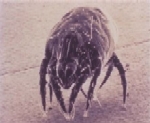Indoor allergies and asthma disproportionately affect African-Americans, Mexican-Americans and residents of low-income housing, results from the Third National Health and Nutrition Examination Survey show.
The results were published in the November issue of the Journal of Allergy and Clinical Immunology (JACI), the peer-reviewed, scientific journal of the American Academy of Allergy and Immunology (AAAAI). Researchers stress, however, that racial differences alone do not account for high rates of asthma morbidity among certain ethnic groups. Racial disparities in housing, community, or both may play a role.
 | Dust mite protein is one of four allergens recently associated with a higher incidence of indoor allergies in certain populations. |
|---|
Studies revealed significant racial disparities in sensitivity, especially to cockroach allergen, dust mites and A. alternata in particular. The findings are noteworthy because sensitivity to these allergens is associated with an increased morbidity rate from asthma.
Percent of Children Sensitive to any Allergen
- All children, 43%
- Caucasian , 41%
- African-American, 52%
- Mexican-American, 43%
Cockroach Allergen. African American children are more than twice as likely to be sensitive to this allergen than are white children. Mexican Americans also showed a significantly higher rate of sensitivity. Family history of allergies, older age and male gender were also associated.
Percent of Children Sensitive to Cockroach
- All children, 20%
- Caucasian , 16%
- African-American, 33%
- Mexican-American, 25%
Dust Mite. Non-white race ethnicity had a strong independent association to dust mite sensitivity. Both African- and Mexican-American children had higher odds of sensitivity. Male gender residence outside the western U.S. and older age were also correlated.
- All children, 25%
- Caucasian , 24%
- African-American, 29%
- Mexican-American, 24%
Cat Allergen. No significant race-ethnicity correlations were seen in sensitivity to cat allergen. Older age and a family history of allergies or asthma were associated.
- All children, 15%
- Caucasian , 16%
- African-American, 15%
- Mexican-American, 12%
A. Alternata. African-American children were twice as likely to be sensitive to A. Alternata than white children were. Male gender, family history of allergies or asthma were also significant for sensitivity.
- All children, 16%
- Caucasian, 14%
- African American, 22%
- Mexican American, 17%
The results show evidence that racial differences in cockroach allergen sensitivity previously noted in local studies of asthmatics exist nationally in the general population, independent of other socioeconomic factors. Studies have also shown that indoor allergens are more prevalent in the homes of asthmatics living in inner city areas. Differences in sensitivity tot these allergens are consistent with racial differences in asthma morbidity. In combination with other data, these findings suggest that racial disparities in housing, community environmental quality, or both may help determine national patterns of asthma morbidity.
For more information, visit the American Academy of Allergy, Asthma and Immunology’s web site at www.aaaai.org.

